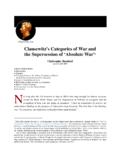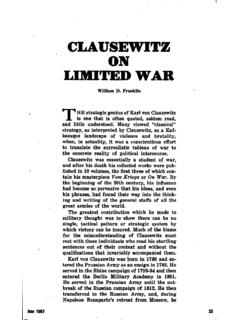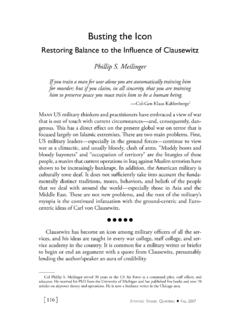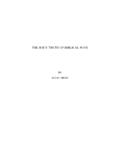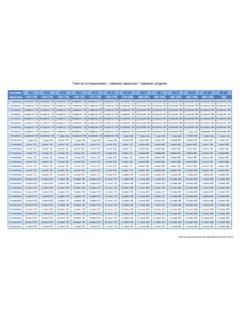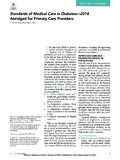Transcription of ON INDEXING ON WAR - clausewitz.com
1 1 ON INDEXING ON WAR by Jon Sumida The index of On War offered here takes the form of a concordance that is, a list of distinctive phrases or summary statements of particular propositions in Clausewitz s treatise, organized by Each distinctive phrase or summary statement is referenced to its place in On War by book and chapter, and by page number in both the Princeton University Press and Everyman versions of the standard translation of Michael Howard and Peter The subject headings include the titled subjects of all eight books of On War and a number of chapters. In these cases, the listing of distinctive phrases and summary statements is preceded by a listing of book title or chapter title with references to book or book and chapter. For the sake of convenience, seven elements of the subject heading Moral Factors are listed as separate subjects,3 with the listing of distinctive phrases and summary statements of particular propositions of the latter included in the former.
2 Where appropriate, distinctive phrases and summary statements of particular propositions are listed under more than one subject heading. The main body of the concordance is preceded by a list of subject headings. The choice of subject headings was determined by the major concerns of Clausewitz, by the major topics of current critical discussion of On War, and by the judgment of the concordance compiler with respect to matters that have received relatively little if any attention but which are nonetheless concerned with the exposition of major argument in On The first category consists of subjects referred to by Clausewitz in his book and selected chapter titles. The second category includes such subjects as Center of Gravity, Dialectical Expression, Escalation, and Trinity.
3 The third category includes such subjects as Language, Limitations of, Uncertainty, Unconscious, and Waiting. In order to reduce the number of subject headings for the sake of simplicity, a single subject heading has been used to cover distinctive phrases or summary statements of particular propositions that are about closely related Translation problems are noted where the result is text that misrepresents significantly Clausewitz s This concordance offers considerably more than the existing indexes of the standard English translation of On War. The first edition of this work, which was published in 1976, did not have an 1 An abridged version of this index was published as A concordance of Selected Subjects in Carl von Clausewitz s On War, Journal of Military History, 78 (January 2014): 271-331.
4 The unabridged text presented here differs from the published abridged text by providing references to book and selected chapter titles, and by incorporating a number of additional references, rephrased references, and minor corrections. 2 Carl von Clausewitz, On War, ed. and trans. Michael Howard and Peter Paret, (Princeton, NJ: Princeton University Press, 1976; 1984; paperback 1989/New York: Alfred A. Knopf, Everyman s Library 121, 1993). 3 Boldness, courage, desperation, determination, military spirit/virtue, perseverance, timidity. 4 For which see Jon Tetsuro Sumida, Decoding Clausewitz: A New Approach to On War (Lawrence, KS: University Press of Kansas, 2008; paperback edition 2011). 5 For example, People s War serves as a subject heading for all distinctive phrases and summary statements of particular propositions about arming civilians, guerrilla war, national insurrection, national militias, protracted defensive war, Spanish resistance to French occupation, and so on.
5 6 For the response of Peter Paret to one correction, see Translation, Literal or Accurate, Journal of Military History, 78 (July 2014): 1077-1080. 2 index. This shortcoming was partially repaired in 1984 with the publication of a slightly revised edition with an index of names and places, and a separate chronological index of wars, campaigns, and battles, compiled by Rosalie In 1993, a differently paginated edition of the Howard/Paret translation was published in the Everyman s Library series. West s indexes were retained with new pagination, but were otherwise unchanged. The lack of a comprehensive subject index integral to either of the Howard/Paret editions of On War prompted the production of two subject indexes by other parties: the SAMS Conceptual Index to On War, compiled by Seminar Four of the School of Advanced Military Studies, Seminar, Class of 1994-5, the latest redaction of which was completed in 1998, and a computer-generated Word Index to Carl von Clausewitz s On War compiled by Christopher Bassford in 1998 and last updated in Both are intended for use with the Princeton University Press variant of the Howard/Paret translation, with page references that are not valid for the Everyman edition.
6 The SAMS and Bassford indexes consist of an alphabetized list of subjects with page references for each one. The SAMS index list approximately 900 key word and concepts, including many of the names, places, and operational events covered by the West indexes. The task of correlating key words and concepts to page references was accomplished by a team working over several months. The Bassford index list roughly 1,200 key words and word groups and includes all of the names, places, and operational events covered by the West indexes. The Bassford index used computerized word search action to correlate word and word groups to page references, which in cases of important subjects are numerous for example, the term defence is given 87 page references. The concordance presented here lists over 2,800 distinctive phrases and summary statements of propositions (including repetitions) grouped under 65 subject headings.
7 It does not include references to the material covered by West. The compilation of the concordance was initiated by the conversion of detailed notes made from the compiler s repeated reading of the Howard/Paret translation of On War over the course of twenty years into the format described in the opening. The list of referenced statements was then greatly expanded by careful examination of the page references to selected subjects provided by the Bassford index. After this, the text of the Howard/Paret translation was reread to find additional statements that deserved referencing. The concordance thus represents a synthesis of manual and machine compilation. In addition to providing references to the Everyman as well as Princeton edition of the standard translation, the concordance enables readers to access particular sections of the text with much greater specificity than the SAMS and Bassford subject indexes by breaking down the representation of a subject into its basic components that is, distinctive phrases and individual propositions.
8 This has several benefits. First, readers are provided with a means of quick reference to Clausewitz s distinctive phrases and significant propositions. Second, the listing of propositions in the order in which they appear in the text with references to location by book and chapter as well as page, enable readers to gain a clear sense of the distribution of Clausewitz s treatment of a subject at a glance. And third, the length of listed propositions provides an 7 Howard and Paret noted that West s index was modeled on the indexes of Werner Hahlweg for the critical German edition of On War published in 1952. The 1980 edition of this work contains an index to concepts and key words, for which see Carl von Clausewitz, Vom Kriege, ed.
9 By Werner Hahlweg (Bonn: Ferdinand D mmlers Verlag, 1980), pp. 1382-1403. 8 They are accessible on the Clausewitz Home Page [ Indexes to Clausewitz s On War : ]. 3 indication of the relative importance of certain subject headings that would not otherwise be apparent from the formal outline of book structure given in the table of contents. A fourth benefit is that a detailed inventory of the distinctive phrases and significant propositions that constitute Clausewitz s view of a subject allow productive study of that subject that would otherwise be more difficult or even impossible. For example, this concordance provides a convenient means of identifying contradictory propositions put forward by Clausewitz in On War. This is the necessary prerequisite to the systematic assessment of the problem of incompatible statements, an issue that has been a source of major confusion and This concordance also enables readers to discern patterns of meaning that would otherwise be inaccessible.
10 In On War, Clausewitz s total view of many important subjects does not exist in the form of a single discrete proposition or explicitly connected set of propositions, but are expressed in numerous and scattered statements that describe the subject differently depending upon the aspect of the subject being considered or differing contexts. To comprehend Clausewitz s complete view of a complex subject with contingent characteristics, a reader must come to terms with a multitude of separate elements and their relationship to each other. This concordance provides the means of juxtaposing all the separate elements that constitute Clausewitz s representation of his thought about a particular subject in a manner that facilitates comprehensive inspection, which is the necessary basis for productive assessment of that thought.

